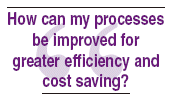 I remember some years ago visiting a clothing company in Kettering, Northamptonshire who employed several hundred staff. The company had a very large plaque on the wall in the reception area recognising those employees who had longevity of service. I recall that there were about 10 names of people who had worked for the company for more than 50 years, and many who had served in excess of 25 years. Being young, and new to the business world I remember being very impressed. A little later I did win some business from them when they were forced to change their IT systems, as support was no longer to be provided for their hardware. The company opted for a simple replacement of their current system with second-hand equipment. Then a few years later I saw a notice in the local paper advertising a liquidation sale of the companys stock, as it had ceased to trade. Whilst the employee loyalty on both sides is to be commended, I realise now that their emphasis reflected the
I remember some years ago visiting a clothing company in Kettering, Northamptonshire who employed several hundred staff. The company had a very large plaque on the wall in the reception area recognising those employees who had longevity of service. I recall that there were about 10 names of people who had worked for the company for more than 50 years, and many who had served in excess of 25 years. Being young, and new to the business world I remember being very impressed. A little later I did win some business from them when they were forced to change their IT systems, as support was no longer to be provided for their hardware. The company opted for a simple replacement of their current system with second-hand equipment. Then a few years later I saw a notice in the local paper advertising a liquidation sale of the companys stock, as it had ceased to trade. Whilst the employee loyalty on both sides is to be commended, I realise now that their emphasis reflected the  philosophy of the companythey were living on vast glories. The simple moral of the story is that if you do not change you die.
philosophy of the companythey were living on vast glories. The simple moral of the story is that if you do not change you die.
Under pressure
Warehouse operations are coming under increased cost and productivity pressures. Customers want smaller just-intime deliveries more often to reduce their stock holding. To achieve the cost benefits of buying in the Far East, purchasing departments want to buy larger quantities with longer lead times. Penalties for inaccuracy can be severe, and deliveries to the large multiples have to be exactly on time. Property and staff costs are increasing. The warehouse operator, whether in house or third party, is in the middle and has to try to reconcile these opposing forces.
 Not a one-time fix
Not a one-time fix
Change is not one off. Businesses must continue to adapt their systems and processes to survive. In the warehouse environment his means analysing each activity to seek improvements. Technology can offer a great deal in support of this quest, but the starting point is the business process. Each organisation must regularly ask itself: How can my processes be improved for greater efficiency and cost saving? For example, you may find that it is hard to manage good receipts effectively. You do not know in advance what is going to arrive, and therefore to predict the staffing requirements in advance. Your business process may involve manually checking your suppliers delivery notes against the goods as they arrive, and then entering the details later into your computer system. This is a time consuming process and mistakes can easily be made. You may determine that there is a better way. If suppliers sent advanced shipment notifications (ASN) then you could predict the resource you would require and allocate your staff accordingly.
The next stage is to consider how IT can help. If the ASN is sent electronically, for example as an XML message, it would arrive more quickly, and there would be no need to enter itmanually into the computer system. Furthermore if all items are bar-coded and the staff equipped with radio linked hand held terminals, they could scan the items as they arrive, removing the need for paper, speeding the whole  process reducing errors andavoiding the need for manual data entry. It is important to start with assessing how the process can be improvedand, as a second phase, consider how IT can support the improved process. If business processes are adapted in this way, then real cost benefits will be delivered.
process reducing errors andavoiding the need for manual data entry. It is important to start with assessing how the process can be improvedand, as a second phase, consider how IT can support the improved process. If business processes are adapted in this way, then real cost benefits will be delivered.

Add a Comment
No messages on this article yet